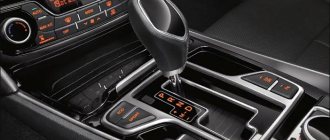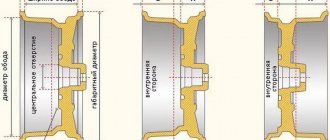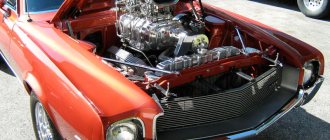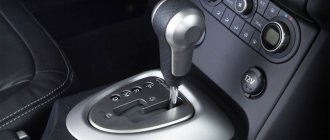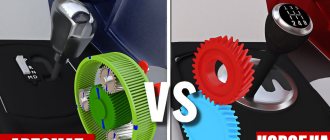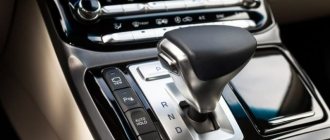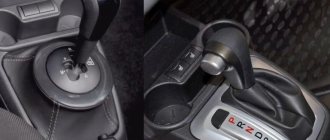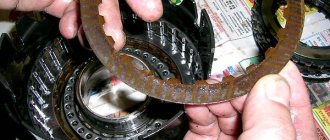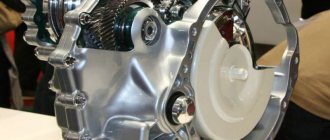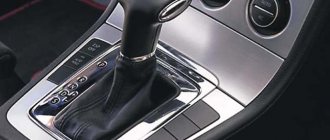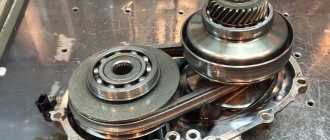In terms of design, the difference between a variator and an automatic transmission is significant. In fact, these are two fundamentally different mechanisms. The automatic transmission includes a torque converter and a gearbox. In simple words, the first one performs the clutch function and switches speeds, the second provides the connection between the gears and wheels. The variator includes 2 pulleys: driving and driven. The connection is provided by a metal cable. The drive wheel is constantly shifting and the belt on the driven pulley covers different diameters. Conventionally, gears are raised or lowered; there are no speeds in the usual sense here.
Differences between the units:
- When the automatic transmission operates, there are jerks. The variator shifts smoothly.
- Acceleration in the second is gradual. The machine is characterized by an uneven speed increase.
- You can't take your foot off the gas uphill with a CVT. The car will roll back. This won't happen automatically.
An automatic transmission lasts less, but is easier to repair.
How to visually distinguish a CVT from an automatic
Without professional knowledge, an ordinary person cannot find the difference. Externally, both units look the same. There are no differences in reality and in the photo.
To understand which unit is installed, you should:
- Study the documents for the car. Inspect the inscriptions on the unit. If the letters “A” or “AT” are present, then the car has an automatic transmission. The designation on the variator is CVT.
- Inspect the unit lever. The letters CVT are often present. This means a variator is installed.
- You can find out the necessary information by examining the switching modes in the box. On the machine they are recorded with the designations PRND, as well as “L”, “2”, “3”. On the variator there is only “L” mode.
There are no other ways to distinguish aggregates. You can understand only in motion.
comparison table
The main differences between the devices under consideration are summarized in the table:
| Criterion | Machine | Variable speed drive |
| Number of modes | Contains more modes. | Fewer modes are used - as a rule, “P”, “N”, “D”, “R”. |
| Designation | "AT" | "CVT" |
| Car behavior when driving | There are jerks and spots. | The movement is smoother. |
| Vehicle behavior when climbing a hill | If you brake and take your foot off the gas pedal, the car will continue to move smoothly forward without rolling back. | When braking while moving up, the car will roll back and will not move forward at idle. |
Advantages and disadvantages
An automatic transmission has the following advantages:
- Ease of use and ease of management.
- Reduced engine wear due to a reduction in the number of errors made by the driver when driving.
- Safety at start. The car will not start if the lever is in any position other than “P” or “N”. This prevents the car from unexpectedly jumping.
- It is impossible to remove the key from the ignition until the box is set to “P” mode. This will prevent the car from moving independently in the absence of a driver.
The unit also has a number of disadvantages:
- expensive unit maintenance;
- increased fuel consumption;
- the need to change the oil after certain periods of time;
- selection during movement of the engine 10% power;
- inability to start the engine from the pushrod.
The advantages of variators include:
- smooth change in speed;
- noticeable fuel savings;
- long service life.
Flaws:
- Difficult to maintain. Only qualified craftsmen can do this.
- The need to change the oil after every 50,000 km. Only synthetics are poured.
- High cost of repairs.
Difference in design
If you look at AT and CVT, both units have completely different devices. There is nothing in common between them, except for automatic gear shifting. Only a specialist can distinguish the boxes externally.
If you look at the design, the operation of the automatic transmission is based on the interaction of the torque converter and the gearbox. The first unit provides pressure, which leads to automatic clicking of the gears. The gearbox consists of shafts, gears and wheels, which are in constant interaction.
The main components of the variator are 2 cone pulleys: driving and driven. They are connected by a high-strength belt drive. By moving the drive shaft between the axles, the distance changes. This causes the belt on the driven pulley to span different diameters. The result is a conditional increase or decrease in gear. There are no gear connections in the variator.
Difference in cooling system
In a car with an automatic transmission, the transmission oil present must have a certain operating temperature. For this purpose, a heat exchanger is installed in the radiator housing of the engine cooling system. It is also called an automatic transmission oil cooler. With its help, the working fluid is constantly in the range of certain values.
The temperature regime of the variator is controlled by a self-diagnosis system. The information comes from the sensor. If the permissible value is exceeded, the indicator provides information about the malfunction and the emergency mode is activated in the variator. An additional radiator is also built in to ensure the required oil temperature. It helps stabilize the heat.
By comfort level
There are no fundamental differences in controlling an automatic transmission or a CVT. If a person likes smooth movement without sudden accelerations, he should choose the second. There are fans who prefer a harsh ride. It is better for them to travel in a car with automatic transmission.
In a car with a variator there is no failure under traction. The increase in speed and its decrease are gradual. On an automatic, it takes a while to change gears. When accelerating the car, shocks may be observed.
Some drivers are annoyed by the sound of the engine of a car with a CVT. If you add gas and increase the speed, the rumble increases, but there is no noticeable increase in speed.
Features of CVT driving
The CVT gearbox is designated by the Latin abbreviation CVT. In terms of its functionality, it is not much different from other checkpoints, but their operating principles are completely different. No shocks are felt when changing gears.
This happens because the diametrical plane of the driven and driving disks is corrected, and the machine accelerates smoothly, without shocks. The driver does not need to be distracted by changing the speed mode. Thanks to the automatic system, acceleration time is reduced and fuel is consumed more economically. The most optimal mode of the propulsion system is also selected automatically.
Even if the accelerator is completely “drowned”, the driver will not hear the sound that sports cars usually make. The excess load on the unit is removed using a smart electronic system.
CVT or automatic: comparison, which is better and more reliable
Automatic transmission is more suitable for use in difficult conditions. The delicate CVT doesn't stand up to comparison. Its belt drive can quickly fail when driving off-road.
On the technical side, the defects in the automatic transmission have been eliminated. The machine has been produced for a long time and improvements have been constantly made to the design over the period. If you change the oil in the machine in a timely manner, the box will last a long time.
The design of the variator is simpler. However, it has a shorter history and often has problems with repairs. The reason is the lack of specialists with the required qualifications. The quality of operation of a CVT is no worse than that of an automatic machine, and with good maintenance the unit can last for a long period.
When choosing, a lot depends on the plans for using the car. To work in difficult conditions, it is better to use the option with automatic transmission. When driving around the city with a smooth increase in speed, choose a CVT.
No need to load too much
When using a car with a CVT, it is highly not recommended to sharply increase the load - the increase should only be smooth, otherwise a visit to the service station cannot be avoided. This is a significant disadvantage of this mechanism, and this problem still remains unresolved. In cold weather, the variator must be warmed up, since the cooled oil will flow through the system very poorly, which is why some parts may be left without lubrication.
This operation must be performed as follows: the car is placed in “neutral” for a while (4-5 seconds is enough). This will help warm up the clutch slightly. You can move off only when the car is completely warmed up. At this moment, all elements of the gearbox have not yet fully warmed up, so it is not worth sharply increasing the speed for at least another kilometer after the start of movement. Even though the fuel consumption will be slightly higher, the driver will be able to save on replacing the gearbox, because the CVT model is a rather capricious thing and can easily break if used incorrectly.
The time for warming up the box directly depends on the air temperature - the lower it is, the longer it takes to warm up.
Experts recommend not to drive cars with manual transmission at all when the temperature drops to minus 35 degrees. But this is not always possible. If you happen to go on a trip in the cold, then you need to warm it up for at least half an hour, and the ride itself should take place in a gentle mode.
As you know, it is almost always cold in Finland, which is probably why an alternative method of warming up cars with manual transmission was invented there. There, some car models are equipped with special plugs, through which they are connected to the electrical network. This way the car warms up quickly. Such cars have characteristic cutouts on the bumpers.
By lever
How to distinguish an automatic transmission from a CVT visually? You should pay attention to the gear shift lever. It is worth noting that the variable transmission is very different from the lever on an automatic transmission. However, there is one caveat: if you purchase a model that has already been used before by another owner, then there is a chance that you will not find any differences. After all, he can alter this handle in such a way that it will be completely unclear what kind of transmission it is. The owners make the selector completely different, and it’s all for the sake of beauty in the cabin.
Cannot be towed
The unit may suffer serious damage if a CVT-equipped vehicle is towed by another vehicle. By the way, when slipping, certain problems may also arise.
The vehicle's operating instructions provide an option for towing another vehicle. If this cannot be avoided, then towing should be carried out in strict accordance with the instructions. But even in this case, the possibility of breakdowns cannot be completely excluded. This is especially true for cars with significant mileage.
Slipping can also be dangerous. If the car is stuck in mud, it is better to give up trying to get out on your own, otherwise this may lead to wear on the spline joints. The gear life will also be significantly reduced. But repairing this unit can hit your pocket hard.
How does a manual transmission work?
The mechanics are simple. The body contains:
- primary, secondary, intermediate shafts with gears, additional shaft and reverse gear;
- synchronizer clutches;
- differential;
- crankcase;
- gear shift rod and fork;
- crankcase (half filled with transmission fluid).
On top of the box there is a gear selection mechanism with locking and locking devices. The gear shift lever is located in the cabin and is capable of moving in the longitudinal and transverse directions.
During operation, torque from the engine is transmitted through the clutch to the input shaft. The rotation speed is converted by the helical gears and then transmitted to the wheels. If the gear increases torque, then the engine speed decreases (and vice versa). In the classic case, 2 or 3 shafts are used for this.
The selection of the desired pair of gears to transmit the required torque under certain driving conditions is done using shift forks, which are driven by a selector.
Manual transmission
The following malfunctions are typical for manual transmissions:
knocking noise when driving and changing gears;
impossibility or difficulty of switching on speeds;
oil leak from the crankcase;
spontaneous switching off of gears.
Such problems arise due to wear of gearbox parts, loosening of fixing bolts and nuts, so a car with manual transmission requires timely maintenance.
Types of automatic transmission: torque converter, variator, robot
Automatic gearboxes (abbreviated as gearboxes) most often include the following devices:
- Torque converter (classic automatic);
- CVT (CVT);
- Robotic gearbox (robot).
Each of them has its own differences, pros and cons. So, before identifying the winner, we should consider them all in more detail one by one.
Torque converter (classic automatic transmission)
Torque converters are so common that this particular type of automatic transmission has become a common name for all other types of automatic transmissions - “automatic transmission”.
